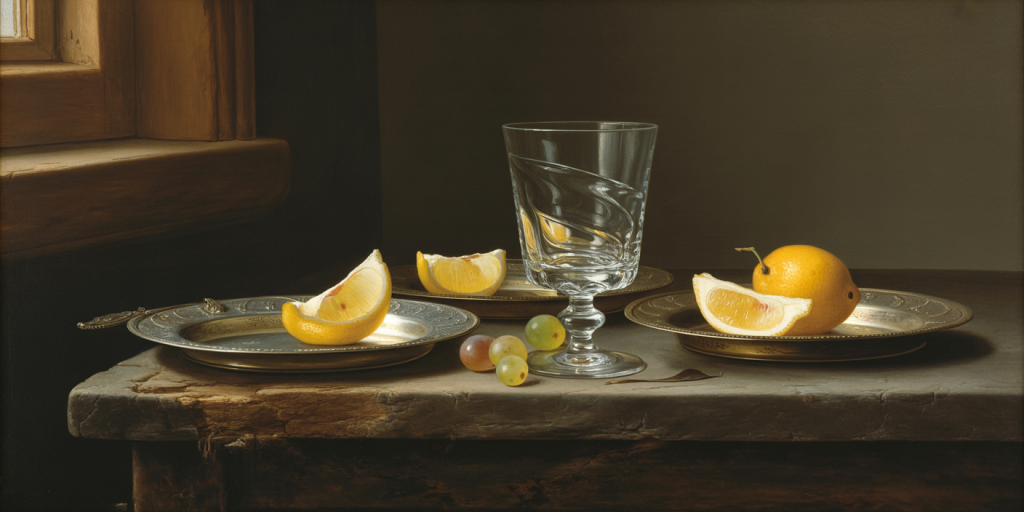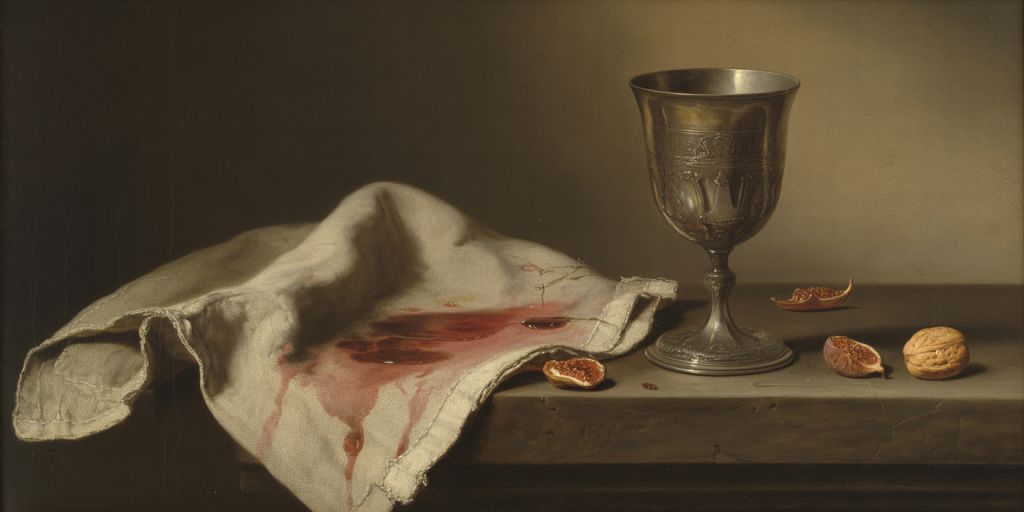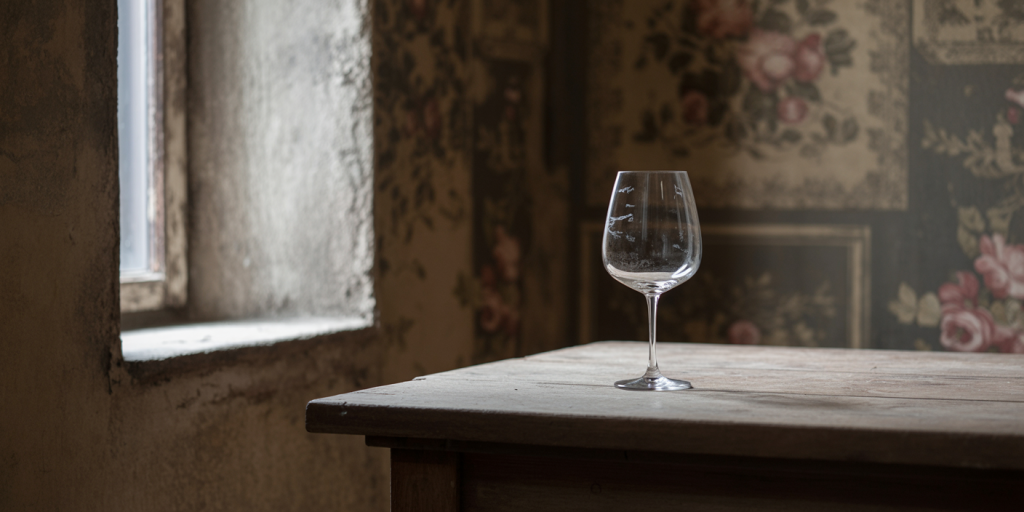The Empty Glass of Heda and the Echo of Conversations Concluded
Willem Claesz Heda
A Moment After Meaning
There are paintings that speak, and others that have already finished speaking. In the still lifes of Willem Claesz Heda, we encounter not the feast, but what remains once appetite retreats and laughter fades. His table is not a celebration—it is a memory. And at the center of it all: a glass, empty. Clear, reflective, almost breathing. A witness to a conversation now silenced.
The empty glass does not mourn, but it listens. It holds no liquid, yet it is full—of traces, reflections, and echoes. It is the vessel of afterthought, of the sigh that follows speech. In Heda’s work, silence becomes tangible, and absence more precise than presence. The mundane is transformed not through grandeur, but through restraint—through the lingering grace of what has been left behind.
Table of Contents
- The Glass as Ghost
- Shadows that Whisper Across Pewter
- Bread Crumbs and the Fragility of Time
- A Lemon Curl Like a Closing Sentence
- The Knife That Reflects and Forgets
- When Silver Grows Tired
- Color in a World of Grays
- The Napkin That Remembers the Hand
- Light as an Old Friend
- Silence Composed in Layers
- The Table as a Landscape of Loss
- Fragments of Opulence
- Stillness as a Language
- The Conversation Between Glass and Bread
- Cracks in the Surface of Reflection
- Refined Decay, Intentional Disarray
- The Weight of What’s Missing
- Chiaroscuro of the Unspoken
- A Still Life That Breathes Regret
- The Echo at the End of the Meal
The Glass as Ghost
The empty glass in Heda’s compositions does not vanish in its transparency—it insists. It sits slightly off-center, distorted by light and curved by its own fragility. It becomes an anchor in a table of scattered remains.
Symbolically, the glass is more than absence—it is a ghost of presence. It once held wine, conversation, intimacy. Now it holds silence, and in doing so, it reflects more than it ever contained.

Shadows that Whisper Across Pewter
Shadows in Heda’s work do not fall—they whisper. Across plates of pewter, they slide like voices reduced to breath. These shadows are the lingering residue of motion, the dimming of presence.
Technically, they define form with remarkable subtlety. Emotionally, they suggest what is no longer here: the hand that held the goblet, the elbow that leaned, the candle that has gone out. Pewter reflects not just light, but memory.
Bread Crumbs and the Fragility of Time
Few crumbs scattered on the cloth, often overlooked, are where Heda’s mastery whispers. Each one a reminder of time passing. Once part of a whole, now detached, almost forgotten.
These crumbs hold intimacy—they are what remains after sustenance, after communion. Their fragility contrasts with the solidity of goblets and knives, reminding us that the smallest remnants carry the deepest echoes.
A Lemon Curl Like a Closing Sentence
The lemon peel spirals downward, as if finishing a thought. It hangs suspended, both in space and in narrative. Its color sings in a muted composition, a final note in a minor key.
Symbolically, the lemon curl is a gesture of completion. Once bitter, once useful—now it adorns the moment after. The curl is not just a visual flourish; it is the punctuation of an event no longer present.
The Knife That Reflects and Forgets
The knife lies across the table, often catching a sliver of light. Its blade is both separator and connector—dividing bread, reflecting objects. It is sharp, yet passive.
In Heda’s hands, the knife is less weapon, more metaphor. It is the memory of motion, now stilled. And in its reflection, distorted and fleeting, we see how perception itself blurs once meaning is gone.
When Silver Grows Tired
Silver in Heda’s still lifes is never pristine. It is dulled, scratched, lived-in. These are not untouched objects; they are bearers of use. They have history rubbed into their surfaces.
This aging is not decay—it is dignity. The silver does not shine to impress, but to remember. Its tiredness is beautiful because it has been touched, handled, trusted.
Color in a World of Grays
Heda’s palette is modest—grays, browns, ochres, muted greens. But within this restraint lies deep emotion. Each hue is chosen not for spectacle, but for atmosphere.
This is not a world of color, but of tone. The emotional resonance is built through temperature and saturation, not hue. The effect is one of hushed intimacy, as if the colors themselves are careful not to speak too loudly.
The Napkin That Remembers the Hand
Often partially crumpled, the napkin in Heda’s works carries a ghostly warmth. Its folds suggest recent use. Its fabric, tender in texture, contrasts with the hardness of metal and glass.
Emotionally, the napkin is the most human object on the table. It remembers touch. It embodies presence through absence. Its softness breaks the austerity of stillness, hinting at gesture now withdrawn.
Light as an Old Friend
Light in Heda’s compositions is never harsh. It moves like breath, caressing rather than revealing. It touches metal and cloth like an old friend—gentle, intimate, nostalgic.
This light carries time. It marks the transition from night to morning, from event to echo. It does not illuminate—it lingers. And in that lingering, it warms what has been left behind.
Silence Composed in Layers
Each object in Heda’s painting is placed not just for visual balance, but for emotional rhythm. The composition is a choreography of silence. A glass here, a plate tilted there, the spoon just off-center.
These are not static objects—they form a symphony of stillness. Each layer of arrangement builds the silence deeper. The canvas becomes not a depiction, but a soundless sonata.
The Table as a Landscape of Loss
The tabletop in Heda’s work becomes a vast plain. A geography of intimacy. Its surface holds echoes of elbows, plates once full, words exchanged. Now it stretches like a memory—flat, tactile, mournful.
We scan this landscape like archaeologists of feeling, seeking what came before. The table does not just hold things—it holds stories, breath, laughter now gone.
Fragments of Opulence
Heda’s still lifes often feature objects of wealth—silver, porcelain, Venetian glass. Yet they are not displayed triumphantly. They are scattered, overturned, half-full.
This is not a boast of luxury—it is a meditation on impermanence. Wealth becomes fragmentary. Opulence, when deserted, becomes almost melancholic. The fragments do not glitter—they whisper.
Stillness as a Language
In Heda’s hand, stillness speaks. It articulates what movement obscures. Each brushstroke, though small, is precise. The paint does not shout—it rests.
This stillness is not merely visual—it is psychological. It invites contemplation, asks us to pause. It creates a space not of absence, but of presence too complete to move.
The Conversation Between Glass and Bread
Objects do not exist in isolation in Heda’s compositions. The glass leans toward the bread. The lemon peel touches the silver. There is dialogue between materials, between textures.
These conversations are silent, but rich. They echo the human voices once in the room. The objects, now alone, speak in gestures—inclinations, shadows, proximity.
Cracks in the Surface of Reflection
The reflected world in a silver cup or goblet in Heda’s still lifes is rarely perfect. It bends, fractures, distorts. What is reflected is not always visible—and what is visible may not be real.
These imperfections become symbols. They speak to the flaw in memory, the distortion of nostalgia. We never see things as they were—only as they remain refracted through time.
Refined Decay, Intentional Disarray
There is disorder in Heda’s table: a glass tipped, a lemon half-peeled, a napkin carelessly dropped. Yet it is never chaos—it is composed decay.
This intentional disarray reveals the human hand behind the scene. The painter’s control allows the illusion of spontaneity. Decay is elevated to elegance, entropy to grace.
The Weight of What’s Missing
Heda’s still lifes are as much about what’s not there as what is. The missing figure, the empty chair, the absent voice. The glass is empty not because it was never full—but because it once was.
This absence has weight. It hangs in the air above the table. It saturates the scene with nostalgia. The painting does not mourn—but it remembers.
Chiaroscuro of the Unspoken
Light and dark in Heda’s work do not only define form—they create mood. The chiaroscuro is subtle, more breath than contrast. It deepens the psychological space.
The unspoken emotions—regret, gratitude, tenderness—float in these zones of soft shadow. His use of light is not to highlight—but to hold. Darkness becomes a resting place for memory.
A Still Life That Breathes Regret
More than beauty, Heda paints a kind of quiet regret. Not sorrow, but a softness that knows things end. The table is not tragic—but it is truthful.
This truth is comforting. It acknowledges loss without despair. It tells us that even emptiness can be composed, even silence can be golden.
The Echo at the End of the Meal
At the heart of Heda’s painting lies an echo. A murmur of laughter just faded. A warmth still held in the napkin. A glass that once clinked in joy, now silent.
But this echo is not sad. It is gentle, necessary. It reminds us that moments pass, and that their passing gives them meaning. The empty glass is not the end—it is the continuation of memory in stillness.
FAQ – Understanding Heda and His Art
Who was Willem Claesz Heda?
Willem Claesz Heda (1594–1680) was a Dutch Golden Age painter known for his refined still lifes, particularly “ontbijtjes” or breakfast pieces, marked by subtle lighting and muted tones.
What themes dominate his still lifes?
His work explores themes of impermanence, memory, refinement, and the quiet dignity of the everyday. His use of empty vessels and scattered remains invites reflection on transience.
How does Heda differ from other Dutch still life painters?
Heda’s palette is more restrained, his compositions quieter. He focuses on tonal harmony and realistic textures rather than vibrant abundance, favoring introspection over opulence.
What symbolic meanings are present in his works?
Objects like lemons, goblets, knives, and napkins often symbolize wealth, decay, conversation, and memory. Empty glasses suggest absence and emotional resonance.
Where can his works be viewed today?
Heda’s paintings are part of major European and American collections, including the Rijksmuseum (Amsterdam), the National Gallery (London), and the Metropolitan Museum of Art (New York).
Final Reflections – When Silence is the Subject
In the hush of Willem Claesz Heda’s still lifes, we find a world already departed. A table just vacated. A meal just finished. A story just told. His brush does not capture presence—it captures its echo.
And in that echo, we find ourselves. Not in the glass, but in the space around it. Not in the bread, but in the hand that once broke it. He teaches us to see not what is, but what lingers.
The empty glass does not grieve—it testifies. It is full of light, full of memory, full of the quiet that follows meaning. In Heda’s stillness, we find the most human sound: the echo of a conversation that mattered.


